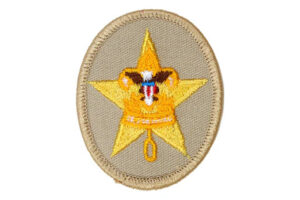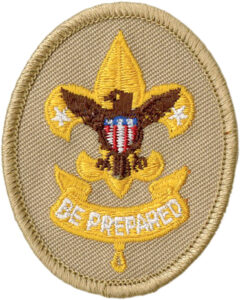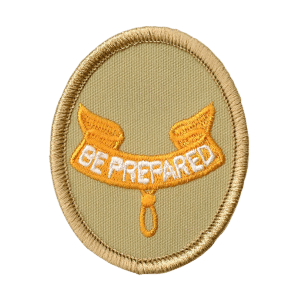Introduction
The beginning of Scouting is often one of most exciting times for its members. Those first few months of being in your new troop are filled with new experiences, people, and adventures. One of the first things many Scouts do is earn the Scout rank, the first rank in Boy Scouts. This rank has Scouts learn about the basic tenets of Scouting and show a few basic skills.
In this article, I’ll walk you through each requirement and give you all the resources you need to make you first few moments in Scouting a success! So let’s get started.
Requirement 1
a. Repeat from memory the Scout Oath, Scout Law, Scout motto, and Scout slogan. In your own words, explain their meaning.
b. Explain what Scout spirit is. Describe some ways you have shown Scout spirit by practicing the Scout Oath, Scout Law, Scout motto, and Scout slogan.
c. Demonstrate the Boy Scout sign, salute, and handshake. Explain when they should be used.
d. Describe the First Class Scout badge and tell what each part stands for. Explain the significance of the First Class Scout badge.
e. Repeat from memory the Outdoor Code. In your own words, explain what the Outdoor Code means to you.
f. Repeat from memory the Pledge of Allegiance. In your own words, explain its meaning.
The requirement has you learn the basics about Scouting. Luckily for you, I already have a post with all the basic information each Scout should know, and that post will cover requirement a, c, e, and f. You can find that post here. For part b and d, I’ll go over them here.
Part B
Scout spirit is a simple concept: Live by the Scout Oath and Law in your daily life. This basic idea carries a powerful message, but as a new Scout, you probably won’t know too much about Scout spirit yet. Scouting spirit is developed throughout your Scouting journey and hopefully by the end of your time in Scouting, you’ll be able to see just important Scout spirit is to you. For this requirement, just knowing the basic idea of Scouting spirit and being able to tell about times you’ve practiced the Scout Oath, Law, Motto, and Slogan should be enough. If you want some more information about Scout spirit, this lesson guide from Scouting.org gives some great explanations and examples of Scout spirit.
Part D
First Class is a significant badge to earn. It signifies the switch from learning physical skills like rope tying and swimming to a focus on developing leadership skills and learning more about Scout spirit. The founder of Scouting, Lord Baden-Powell also said that everyone who joins Scouting should strive to earn First Class. Because of its important, the design of the first class badge is filled with symbolism.

There are 6 main points of symbolism in the badge.
- The 3 points of the trefoil at the top of the badge symbolize the 3 points of the Scout Oath
- The design of the trefoil is also made to reflect that of an old compass. This reflects that Scouts can point the right way in life just as a compass points North
- The two stars on the edges of the trefoil symbolize truth and knowledge
- The eagle and shield on the badge symbolize freedom and a scout’s readiness to defend that freedom.
- The knot at the bottom of the badge symbolizes the Scout Slogan: Do a good turn daily.
- The scroll on the badge bears the Scout Motto – Be Prepared and is turned upwards at the ends as a reminder that Scouts should smile as they do their duty.
Requirement 2
After attending at least one Boy Scout troop meeting, do the following:
a. Describe how the Scouts in the troop provide its leadership.
b. Describe the four steps of Boy Scout advancement.
c. Describe what the Boy Scout ranks are and how they are earned.
d. Describe what merit badges are and how they are earned.
For this requirement, you will learn about the basic structure of Scouting.
Part A
Scouting is often described as a youth lead organization. While there are adults in place to make sure that everything is safe, most leadership in a troop is provided by Scouts. This is done through the different leadership positions. There are 17 different leadership positions that a Scout can hold ranging from Senior Patrol Leader (the highest position) all the way to troop bugler. This article by ScoutSmarts gives some great information about each of the positions but for this requirement you’ll only have to know the basics. The troop is lead by the Senior Patrol Leader(SPL) and Assistant Senior Patrol Leader(ASPL). Each individual patrol in the troop has a patrol leader who reports to the SPL about the troop. This chart from the BSA will give you some more information about the leadership in a troop.
Part B
The 4 stages to Boy Scout advancement are as follows : The Boy Scout learns, The Boy Scout is tested, The Boy Scout is reviewed, and The Boy Scout is recognized. This progression system is used for everything from rank advancements to merit badges. More detail about the 4 steps to advancement can be found here. Remember that you’ll only be expected to know the basics as, after all, Scout is only the first of many ranks.
Part C
There are 7 ranks in Scouting: Scout, Tenderfoot, Second Class, First Class, Star, Life, and Eagle. Each of these ranks require Scouts to learn new skills and grow as both Scouts and people. Rank advancements are designed to guide Scouts on their journey through Scouting. They are earned by first completing each of the requirements, as you’re doing with the Scout rank right now. After each requirement has been completed, the Scout completes a Scoutmaster conference. During this conference you’ll have a conversation with your Scoutmaster about what you learned completing that rank and how you plan to use what you learned to better the troop. After your Scoutmaster conference, you’ll have a board of review. For a board of review, you’ll sit down with 3-5 adults from the troop and be, as the name suggests, reviewed. They’ll ask questions to make sure that you did each requirement but also might ask things like your plans in Scouting.
Part D
Merit badges are a way for Scouts to learn and demonstrate new skills. There are more than 135 merit badges you can earn on topics ranging from shotgun shooting to chess. Each merit badge follows a similar formula, which can be found from the BSA here. To summarize
- Pick a subject
- After you’ve picked your badge, obtain a merit badge application and fill it out with your information. Your Scoutmaster should be able to help you with this process.
- Find a counselor for the badge
- Merit badge counselors are people certified by the BSA to teach a badge. To find one, try asking your Scoutmaster or search the internet with your parent’s permission
- The buddy system must always be used when meeting with merit badge counselor – BSA safety guidelines prohibit adults meeting with Scouts 1-on-1.
- Work on the requirements
- Your counselor should be able to give you some guidance on the requirements for your badge.
- Show your stuff
- Now you’ll have the chance to show what you’ve learned to your counselor. They’ll have you demonstrate how you’ve satisfied each requirement for the badge. This process will vary from badge to badge
- Get the badge!
- After you’ve completed all the requirements, give your finished merit badge application(commonly called a blue card) to your unit leader. You’ll then receive the badge at your troop’s next court of honor.
Requirement 3
a. Explain the patrol method. Describe the types of patrols that are used in your troop.
b. Become familiar with your patrol name, emblem, flag, and yell. Explain how these items create patrol spirit.
Patrols are the building block of Scouting. Troops rely on patrols ability to function as both a combined unit and individually. Patrols also offer you the chance to plan any fun Scouting event that you can dream up for you and your friends.
Part A
The patrol method aims to help Scouts build skills and character. Patrols are made up of 6-12 Scouts, usually of similar ages who work together to achieve their goals. The patrol method teachers Scouts to work as a team with their patrol. One common application of the patrol method is at troop campouts. Each patrol might bring their own patrol box where they keep their own tools for cooking, chopping firewood, and other camp tasks. This shows the ability of a patrol to function independently of the troop. Information about types of patrols can found from the BSA here. I think this quote from founder of Scouting Lord Baden-Powell sums things up well –
“The patrol system is not one method in which Scouting can be carried on. It is the only method.”
—Lord Baden-Powell
Part B
Each patrol in a troop decides on their own name, emblem, flag and yell. Patrol names can really be anything. My patrol called ourselves the Spruce Lee (a play on Bruce Lee; there was another patrol in my troop called the Woodchuck Norris). Many patrols name themselves after animals or other figures such as lumberjacks. The patrol emblem is a patch that is worn on right shoulder of your uniform. They can be purchased from the official Scout Shop here. The patrol flag usually is based of the patrol emblem and is flown at patrol and troop campouts and events. The patrol yell is a short yell that can be used to call the patrol to attention or identify the patrol. For example, my patrol’s yell was “We’ve been splitting wood since 2004.” I encourage you to be creative
Each of these aspects of the patrol build patrol spirit. Patrol spirit is a feeling of comradery between patrol members. A patrol that has a strong patrol spirit will be able to work well together and achieve their goals
Requirement 4
a. Show how to tie a square knot, two half-hitches, and a taut-line hitch. Explain how each knot is used.
b. Show the proper care of a rope by learning how to whip and fuse the ends of different kinds of rope.
For requirement a, you’re already in luck. I’ve already made a post about how to tie each Scouting required knot which can be found here.
As far as rope care goes, there are two main ways to care for your rope. Both methods are used to control frayed ends of rope that are created when ever you cut a rope. Fusing is the easiest method but only works for synthetic rope. It involves melting the end of the rope’s plastic fibers and then smooshing them together. This connects the ends of the fibers and prevents them from separating. Take great caution when fusing to avoid burning yourself. Whipping is used for natural fiber ropes. Dental floss is commonly used when whipping it is readily available and a good size and strength. You can find a step by step guide for whipping here.
Requirement 5
Demonstrate your knowledge of pocketknife safety.
If you earned your Whittling Chip as a Weblos Scout you should be set for this requirement. You’ll be required to earn the Boy Scout equivalent of the Whittling Chip, the Totin’ Chip, but you should have a strong enough understanding of pocket knife safety for this requirement. If you didn’t earn your Whittling Chip there are 5 basic ideas in pocket knife safety
- A knife is a tool – Never play with knives
- Only use a knife in a safe area
- When using a pocket knife, you need to keep a safety circle around yourself
- This means that no one should be within reach of your knife while you’re using it
- Don’t use your knife in crowded areas such as by the campfire
- When using a pocket knife, you need to keep a safety circle around yourself
- Always cut away from yourself
- Keep your knife sharp – dull knives are more dangerous than sharp knives
- Never throw knife
You’ll have to go into a bit further detail when you earn your Totin’ Chip but knowing those 5 ideas should be enough to complete this requirement.
Requirement 6
With your parent or guardian, complete the exercises in the pamphlet “How to Protect Your Children from Child Abuse: A Parents Guide” and earn the Cyber Chip Award for your grade.
This requirement varies in its requirements based on your grade level. Requirements for each grade level can be found from the link the requirement or here. Earning the Cyber Chip is very straight forward and shouldn’t take your more than an hour or two. Most new Scouts will complete the Cyber Chip for Scouts grades 6-8. Requirement 4 of this version has Scouts teach others using the EDGE method. The EDGE method is a way of instructing others and it stands for Explain, Demonstrate, Guide, Enable. More information about the EDGE method can be found here.
Requirement 7
Since joining the troop and while working on the Scout rank, participate in a Scoutmaster conference.
This is it! Your last requirement before earning the first rank of Scouting. While having a Scoutmaster conference might seem scary, I promise it isn’t as bad as it seems. Your Scoutmaster is there to help you get the most out of Scouting and they help you do this through Scoutmaster conferences. Your Scoutmaster might even ask you for things they can do better in your conferance.
Conlclusion
Congratulations! You made it through the first rank of Scouting. I hope this guide made your inductions into Scouting as trouble free as possible and also got you excited about what else Scouting has to offer. I plan to continue working on more rank advancement guides to help you on your Path to Eagle. Until then, happy Scouting!





